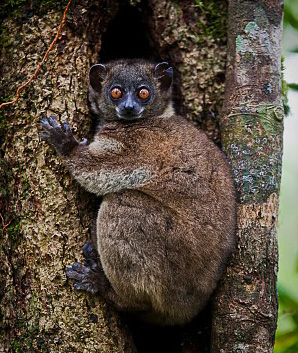Bug-Eyed Over Lemurs!
Finally! Lemurs Abound!
Kasey-Dee Gardner
 We step out of our bungalow in Ranomafana National Park and realize we’re in the middle of the most beautiful rainforest imaginable. It was dark when we arrived last night, so I wasn’t able to fully grasp our surroundings. I am surrounded by massive green trees and in the distance I can hear a waterfall. There’s only one road in town and a few buildings around the park. This is pure nature.
We step out of our bungalow in Ranomafana National Park and realize we’re in the middle of the most beautiful rainforest imaginable. It was dark when we arrived last night, so I wasn’t able to fully grasp our surroundings. I am surrounded by massive green trees and in the distance I can hear a waterfall. There’s only one road in town and a few buildings around the park. This is pure nature.
Our hike starts off early. We’re told lemurs are most active in the morning, so it’s best to reach their ground as they’re waking up. The trail starts off clear and easy through the park. But within 10 minutes, our guide Diamondra is off and running through the rainforest like a lemur himself.
I should have known finding lemurs would be an adventure. They live high in the jungles, deep in the virtually untouched forests. Silestra is already well ahead of all of us – it’s his job stay ahead in forest looking for lemurs. Silestra spots a Milne-Edwards’ Sifaka. Diamondra calls for us to follow. Dan and I dart through the virgin jungles, up the hills, across the rivers to see our first lemur … ever.
There are 100 lemur species exist in Madagascar – about a dozen are found in this park alone. These wild, playful, monkey-like creatures fly through the rainforest canopies and send curious tourists on a chase. Silestra lucks out and find not just one Sifaka, but an entire family. They sit high up in the tress watching us, eating guava, grooming themselves, bouncing from branch to branch.
I stare in amazement. They are beautiful. It’s amazing to see them interact as a family. Diamondra tells me most lemur species are run by the females. This makes me smile. We soak it all in for at least 20 minutes before hearing Silestra’s call from a distance – he’s spotted another species of lemur, the red-bellied lemur.
 This goes on for hours. Every time Dan, Diamondra, and I finally reach a new lemur, Siletra has found another. I know the guides are well trained in the park, but I don’t understand how they find the lemurs. There are virtually no trails in the forest and the lemurs hide deep in the canopies. But, either by luck, instinct, or exceptional training, by the end of a 10-hour hike, we’ve spotted the Milne-Edwards’ Sifaka, Red-Bellied Lemur, Grey Lemur, Great Bamboo Lemur, Golden Bamboo Lemur, Sportive Lemur, the Brown Mouse Lemur, and the Woolly Lemur. Unbelievable … this hike has exceeded all my expectations.
This goes on for hours. Every time Dan, Diamondra, and I finally reach a new lemur, Siletra has found another. I know the guides are well trained in the park, but I don’t understand how they find the lemurs. There are virtually no trails in the forest and the lemurs hide deep in the canopies. But, either by luck, instinct, or exceptional training, by the end of a 10-hour hike, we’ve spotted the Milne-Edwards’ Sifaka, Red-Bellied Lemur, Grey Lemur, Great Bamboo Lemur, Golden Bamboo Lemur, Sportive Lemur, the Brown Mouse Lemur, and the Woolly Lemur. Unbelievable … this hike has exceeded all my expectations.
Both guides work relentlessly to give us the best experience possible. Diamondra knows the local lemur species. He can roll off the top of his tongue their color patterns, sizes, breeding habits, family dynamics and diet. He tries teaching me how to make a lemur call (which kind of sounds like pink grunt and a bird quack combined). Apparently, I’m not much good at this since no lemurs have come to my call.
When the sun sets, we all set off on a nighttime hike to find the nocturnal Mouse Lemur and encounter the bizarre chameleons of Madagascar. It seems like every tree is filled with these reptiles, each one more wild looking than the next. Some are as big as bricks, others are as small as a finger, one is pregnant. I’m beginning to understand why Madagascar is called a living laboratory – the beauty and uniqueness of the species here are overwhelming.
Three tips if you ever decide to travel to Ranomafana: bring hiking boots, wear tight pants with closed legs to prevent leeches, and hire Diamondra and Silesta to be your guides.
Photos: Dan Plimpton
